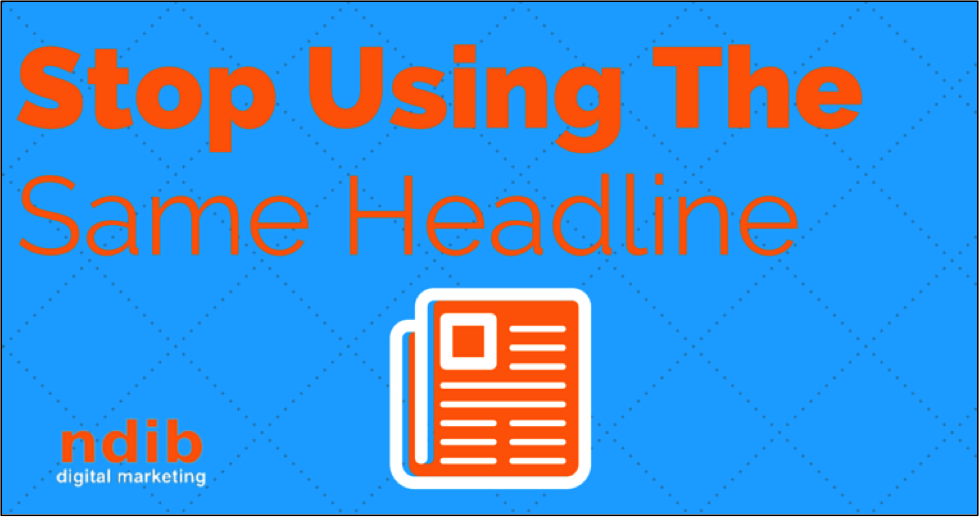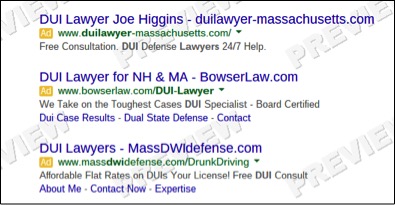
Writing text ads in AdWords is difficult – except crafting the headline.
Every blog and best practice article you read from so-called “experts” tells you to simply include the user’s search query in your headline.
In fact, Google seems to even encourage this practice by offering dynamic keyword insertion and bolding the matching words in the headline of your ads.
So why aren’t you getting clicks?
You run the ad preview tool and discover all your competitors utilize the same keyword based headline structure, so what are you doing wrong? Why are you competitors getting all the clicks? Or are they even getting clicks?
Your click through rate continues to drop, almost as fast as your morale.
You split your keywords into even tighter ad groups to more precisely match the headline to the user’s search query and yet….nothing.
Creating only keyword-based headlines is exactly what I used to do as well – until I learned something interesting about how headlines in AdWords actually work.
Problem: Everyone Creates Keyword Based Headlines

The headline is the first element of your ad a user sees, takes up the most space, and is one of (if not the) most important pieces of ad copy. And yet, for a long time I followed best practice and regurgitated back the same search query the user typed. I did this because it was the way I was taught to structure an ad and because the results were not terrible.
While creating keyword-based headlines may be the ideal headline structure in a vacuum, ads don’t compete in a vacuum – ads compete on the search engine results page. Since the majority of advertisers on the SERP utilize keyword-based headlines, the user sees 10 headlines that are all the same. This tactic of keyword-based headlines begins to lose effectiveness in the real world.
What you need to do is think of your headline from the perspective of the users. Show them what value clicking on your ad provides and take advantage of the fact that your competitors are all being sheep and doing the same thing.
Solution: Think Like Apple – Be Different
Since we know that the headline is one of the most important elements of your ad, and we know that the majority of the headlines on the search engine results page are essentially the same – the solution is to make your headline different.
Make your headline as clickable as possible by being different than the competitors the user sees on the SERP. One of the most effective techniques to differentiate your ad’s headline and to increase your click through rate is to use a value proposition based headline.
How To Effectively Create A Value Proposition Based Headline to Differentiate Your Ad
Here is the way to quickly test out your headline structure and see if a value proposition based headline increases your click through rate over a keyword based headline.
1. Make a List of Possible Value Propositions
Your value proposition is a vital component of your overall marketing message. It differentiates your business from your competitors and immediately informs the prospective customer what the value of doing business with your company is.
You can have more than one value proposition for your company. There can even be separate value propositions for your business, individual products, and even individual ads.
For example, your business value proposition may be that your customers get “Fresh, hot pizza delivered in under 30 minutes” (the famous Domino’s value proposition example) but your ads’ value proposition may be that the consumer get a free eBook, or a free 30 minute consultation, etc.
Make a list of possible value propositions in an excel sheet and rate them by what you estimate will yield you the best click through rate. We will be testing these out as headlines against keywords based headline.
2. Create An Ad With A Value Proposition as a Headline
Take a look at your list of potential value propositions in your excel sheet. Pick the one you rated as likely to yield you the best click through rate, and utilize that value proposition as the headline of an ad.
This means that *gasp*, you will have to do something that is not best practice!
When you utilize a value proposition based headline, your headline looks more like a description line two.
Since there are fewer characters to work with in your headline (25 as opposed to 35), you may simply state your value proposition, but if you have enough room a call to action is appropriate.
3. A/B Test the Headlines to Statistical Significance
Now that you have a value proposition based headline and a keyword based headline, it is time to split test them to statistical significance.
Never just blindly trust a so-called expert (even me!). Split test for yourself and see if utilizing a value proposition based headline does differentiate your ad from your competition and increase your click through rate.
To ensure that you are split testing properly, make sure that you run the different headlines at the same time and that the ad rotation setting on AdWords is set to “rotate indefinitely.”
At NDIB (my company) we utilize the Brad Geddes AdAlysis tool for split testing – I have no monetary interest in it, I just think it is an easy to use tool. However, you can also find out the results of your headline split test by following these steps provided by PPC Hero. It just takes a little more time than an automated tool.
Once you get the results, do not stop testing! In fact never stop split testing. One of the reasons that you made a list of value propositions is to continue to split test them as your headline to find which increases the click through rate the most.
What have you found to be the best headline(s)?



